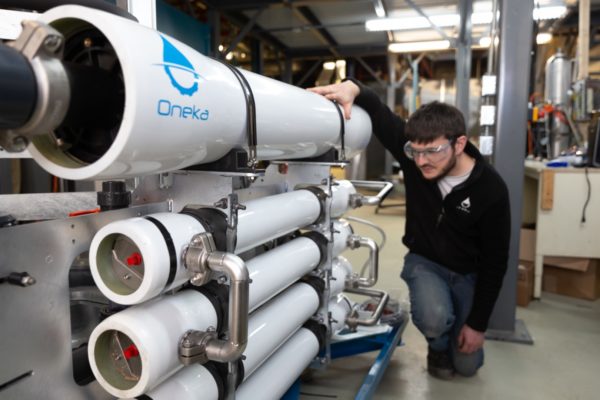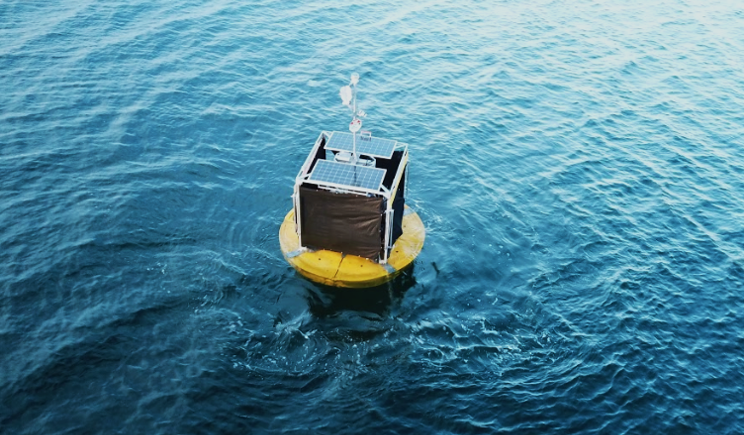Desalination is seen as a path forward to ensuring coastal communities have a steady supply of clean drinking water as populations expand. Historically, desalination projects have struggled to scale widely, as the high amount of energy required to remove salt from ocean water creates costs and damages sustainability.
A Quebec, Canada firm has developed a product to address the energy and environmental concerns of desalination by making a modular, floating buoy that harnesses the power of the sun and waves to turn ocean water into drinkable water. Oneka builds a self-contained, solar-topped device that also harnesses wave power. The two energy sources allow the buoy to draw ocean water in through reverse osmosis, and then convert it to drinkable water.
Oneka said the system benefits from not requiring any land, nor any external sources of electricity. In comparison with a traditional diesel-powered desalination plant, Oneka said its solution can reduce costs by up to 70%. The buoys are usually placed 0.1 to 2 miles from shore, with a depth of at least 35 feet. The units are not visible from the shore with the naked eye for most sites, said the company.
Waves that are just three-feet high are sufficient for the operation of the system, and the ideal wave sizes range between three to ten feet high. Oneka said the system can last fifteen years, and regular maintenance checkups occur quarterly. Each buoy can pump out 10 cubic meters of fresh water each day, and the modular design allows for easy additions of more buoys. serving increased water demand.

Image: Oneka
It is estimated that at current growth rates, the desalination industry will contribute 2 billion tons of CO2 emissions per year by 2050, more than twice the emissions of the aviation sector in 2019. A single buoy can abate about 34,000kg of carbon emissions each year, equivalent to the impact of about five to ten cars.
Oneka said the brine produced by the desalination nodes is environmentally responsible, increasing the ocean water’s salinity by about 30% on average. Each buoy has its own inlet and outlet, allowing for a distributed discharge of salt that can disperse in the ocean quickly.
The company said its product has applications in coastal communities, oceanfront resorts, and private islands. Its first commercially operating project is located in Fort Pierce, Florida, completed last year. Last June, Oneka secured a CA $5.5 million ($4.36 million US) funding round, and has investors across the globe, including Canada, the United States, United Kingdom, Belgium, Chile, and Germany.
“The world is running out of clean water and Oneka has a solution. It works, it’s affordable, it’s better for the environment, and it can be scaled from local disaster relief and regional demand all the way to meeting utility needs,” said Jonathan Saari, investment manager at Innovacorp, one of the leading investors in the funding round.
The US Department of Energy and the National Renewable Energy Laboratory are pursuing modular, wave ]-based desalination buoys, as well. A five-stage, $3.3 million contest aims to accelerate innovation in small, modular, wave-powered desalination systems capable of producing clean water in disaster and recovery scenarios, as well as in water-scarce coastal and islanded locations. The current NREL model, called HERO WEC, does not utilize solar PV.
This content is protected by copyright and may not be reused. If you want to cooperate with us and would like to reuse some of our content, please contact: editors@pv-magazine.com.









By submitting this form you agree to pv magazine using your data for the purposes of publishing your comment.
Your personal data will only be disclosed or otherwise transmitted to third parties for the purposes of spam filtering or if this is necessary for technical maintenance of the website. Any other transfer to third parties will not take place unless this is justified on the basis of applicable data protection regulations or if pv magazine is legally obliged to do so.
You may revoke this consent at any time with effect for the future, in which case your personal data will be deleted immediately. Otherwise, your data will be deleted if pv magazine has processed your request or the purpose of data storage is fulfilled.
Further information on data privacy can be found in our Data Protection Policy.